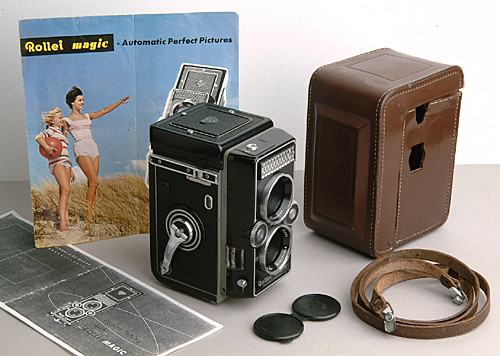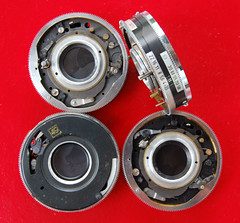Rollei Magic

|
| Rollei Magic (I) image by John Nuttall (Image rights) |
The Rollei magic is a medium format TLR camera manufactured by Franke & Heidecke, Braunschweig, Germany, from 1960 till 1962.
It was Rolleis answer to the desire at that point in time for a TLR with an automated exposure control. Rollei could achieve this when the shutter company Prontor designed a new shutter for just that purpose, the Prontormat-S.
The Rollei magic uses 120 type Rollfilm. 12 6x6cm square images can be captured for each roll of 120 film.
By using a special mask set the camera can be adapted to shoot 16 images 4x4 or 4x5.5cm on a roll. The mask put into the filmgate does automaticly change the frame counter from 12 to 16 exposures.
A big difference with the Rolleiflex is the fact that the Rollei magic uses front-cell focusing instead of moving the whole lens board.
Because many after-sales complaints were received about the lack of a proper manual speed control Rollei came up with a second model, the Rollei magic II to rectify this. That model was produced from 1962 till 1968.
Contents
Specifications Rollei magic
- Taking lens: Schneider-Kreuznach Xenar 1:3.5 f=75mm.
- Viewing lens: Heidosmat 1:3.5 f=75mm (also a Xenar).
- Filter Bayonet : Both lenses, size 2.
- Shutter: Prontor Prontormat-S model 565 k1.
- Automatic exposure: speeds 1/30 to 1/300 sec. at diaphragms 3.5 to 22.
- Manual shutter settings : Flash 1/30 sec. and B, both allowing diaphragms 3.5 to 22.
- Lighmeter system : Selenium cell
- Film speed settings : 12 to 1600 ASA.
- Measurements: 88 x 106 x 147 mm
- Weight: 1000 grams
Specifications Rollei magic II (only differences)

|
| Rollei Magic (II) image by Geoff Harrisson (Image rights) |
- Shutter: Prontor Prontormat-S model 602 k.
- Automatic exposure: speeds 1/30 to 1/500 sec. at diaphragms 3.5 to 22.
- Manual shutter settings : 1/30 sec. to 1/500 and B, both allowing diaphragms 3.5 to 22.

|
| Prontormat-S 602k shutter image by Hans Kerensky (Image rights) |
Bibliography
- Claus Prochnow, Rollei Report 2, third edition, Braunschweich, Lindemanns Verlag, 2008, ISBN 3-89506-220-0.